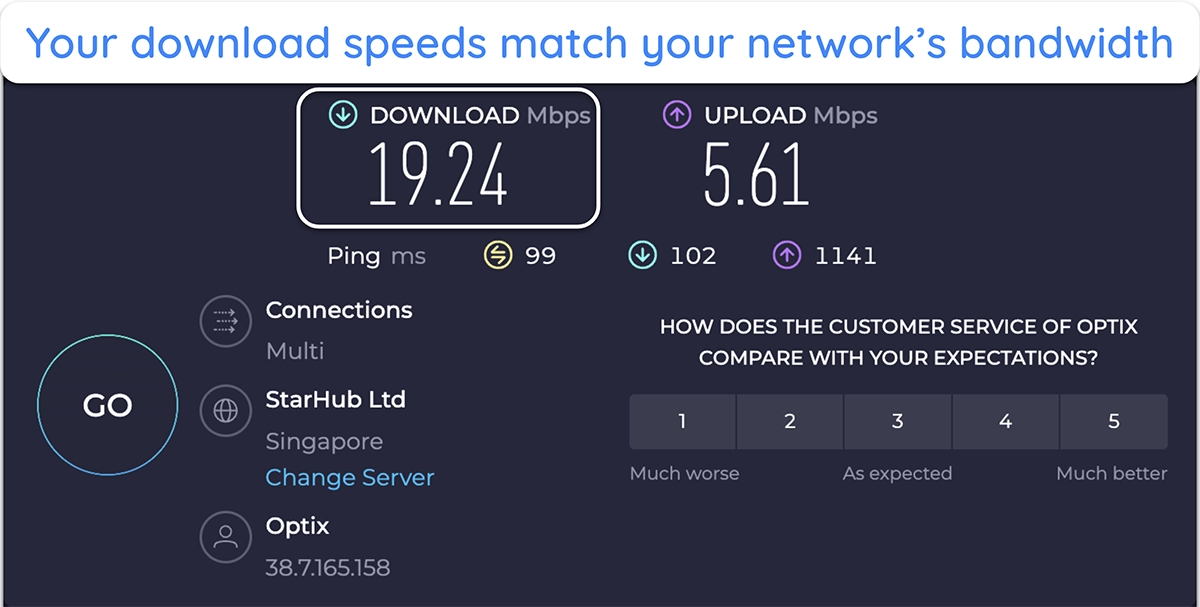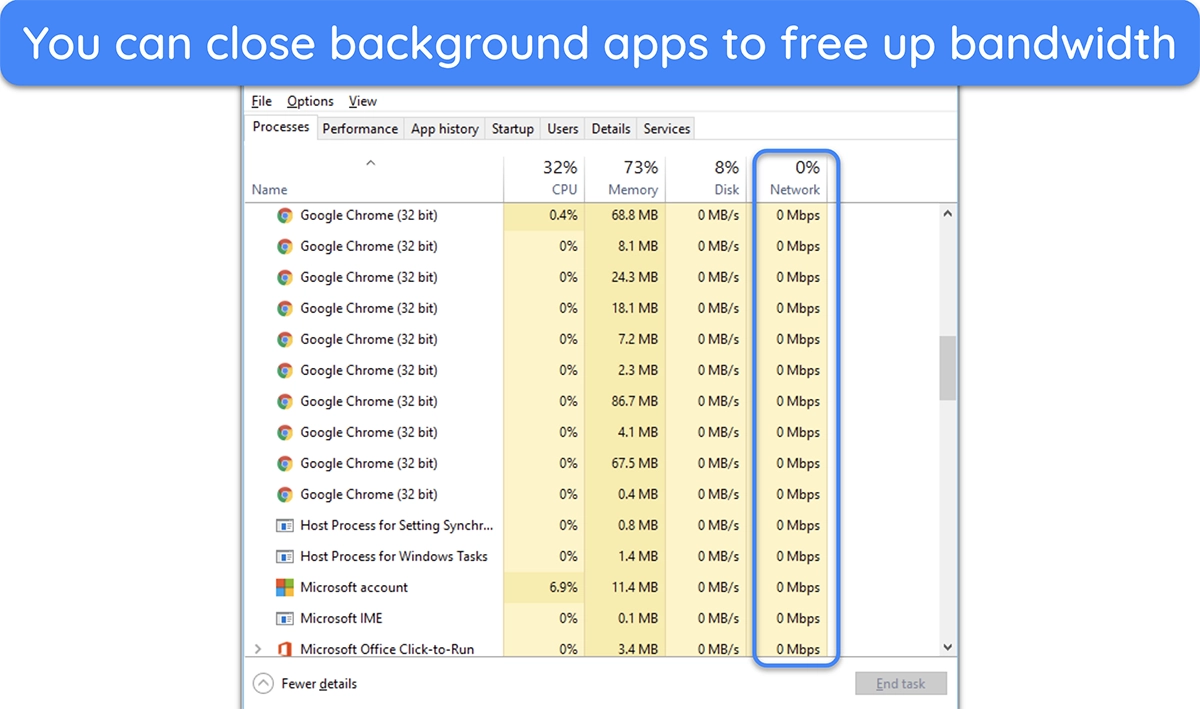What Is Bandwidth? Bandwidth Definition, Importance, & Uses
Bandwidth is the maximum amount of data that can travel across an internet connection in a set amount of time. It’s typically measured in megabits per second (Mbps) or gigabits per second (Gbps). The higher the bandwidth, the faster your connection can handle large amounts of data without slowing down.
Your bandwidth directly impacts how quickly you can stream, download, and browse. With low bandwidth, activities like video calls, gaming, or streaming can lag or buffer. In this guide, you’ll learn what factors affect bandwidth, how to find your internet’s bandwidth, and how to improve it. Editor’s Note: We value our relationship with our readers, and we strive to earn your trust through transparency and integrity. We are in the same ownership group as some of the industry-leading products reviewed on this site: ExpressVPN, Cyberghost, Private Internet Access, and Intego. However, this does not affect our review process, as we adhere to a strict testing methodology.
Quick Summary: What Is Bandwidth?
In simple terms, bandwidth means how much data your internet connection can handle at any moment. You can call bandwidth the “capacity” of your network. For instance, a 20Mbps connection means a maximum of 20 megabits of data can flow through your network at any given time. It can be less than that but not more.
Every online activity like browsing, streaming, or video conferencing, needs bandwidth. The amount depends on the data demands of each task. If multiple devices are connected or high-data tasks run at once, they consume more of your available bandwidth, affecting overall performance.
How Does Bandwidth Work?
Bandwidth manages how data flows through your internet connection based on your internet plan. Here’s a step-by-step look at how it works:
- Requesting data — When you load a web page or start a video, your device requests data from a server. This request travels through your network connection, starting the data flow.
- Transferring data packets — The server responds by sending data in small units called packets. These packets travel along your connection to your device. Bandwidth determines how many packets can pass through at once.
- Processing by your device — As your device receives the packets, it processes and arranges them to display the content or perform the task. This process goes on until the activity finishes.
- Adjusting for multiple connections — If you have several devices or activities going on at once, your bandwidth divides among them. Higher-bandwidth tasks may use a larger share, potentially affecting other activities.
Why Is Bandwidth Important?
Bandwidth is important because it directly affects the quality of your internet connection. Adequate bandwidth results in smooth streaming, faster downloads, and minimal lag. In contrast, limited bandwidth can disrupt online activities, causing buffering, delays, and slow loading times.
In homes with multiple devices or users, bandwidth plays an even bigger role. Every device, in your home consumes part of your bandwidth. Without enough bandwidth, simultaneous activities like gaming, video calls, and streaming can overload the connection.
For businesses, bandwidth impacts productivity and customer service. High bandwidth supports smooth video conferences, quick data transfers, and efficient cloud service use, which are essential in professional settings.
Types of Bandwidth
Not all bandwidth functions the same way; different types serve unique purposes depending on how data flows and what activities are involved.
Symmetrical vs. Asymmetrical Bandwidth
- Symmetrical bandwidth — Offers equal download and upload speeds, ideal for activities like video conferencing and online gaming where both directions require similar data rates.
- Asymmetrical bandwidth — Provides higher download speeds than upload speeds, suitable for users who consume more content than they upload, such as streaming videos or browsing the web.
Digital vs. Analog Bandwidth
- Digital bandwidth — Refers to the data transfer rate in digital networks, measured in bits per second (bps). It’s crucial for internet connections, computer networks, and digital communications.
- Analog bandwidth — Denotes the range of frequencies an analog signal occupies, measured in hertz (Hz). It’s important in traditional telephony, radio, and television broadcasting.
Public vs. Private Bandwidth
- Public bandwidth — Utilizes shared networks like the internet, where bandwidth is distributed among multiple users. This can lead to variable speeds due to network congestion.
- Private bandwidth — Involves dedicated connections, such as leased lines, offering consistent performance and enhanced security, often used by businesses for critical operations.
Uses of Bandwidth
Bandwidth is essential for various online activities, each requiring different amounts to function well. Here’s how bandwidth is used across common tasks:
- Streaming video and music — Services like Netflix and Spotify need significant bandwidth to deliver high-quality content without interruptions. UHD videos demand more bandwidth, and a VPN can let you stream in UHD on restricted networks.
- Online gaming — Gaming requires low latency and consistent bandwidth for real-time interactions. Multiplayer games, in particular, need stable connections to prevent lag and ensure fair play.
- Video conferencing — Platforms like Zoom and Skype use bandwidth to transmit audio and video data. Clear video calls depend on sufficient bandwidth to handle the data flow without delays.
- Cloud services — Uploading and downloading files to cloud storage services like Google Drive or Dropbox consume bandwidth. Larger files require more bandwidth for faster transfers.
- Web browsing and social media — Every webpage you load and every social media post you view uses bandwidth. While individual pages may use less, frequent browsing can add up, especially with media-rich content.
How to Measure Bandwidth?
Regularly measuring your bandwidth helps you understand your network’s performance and ensures you have the right internet plan for your needs. To measure your internet bandwidth, you can use various methods and tools to assess your connection’s capacity:
- Online speed tests — Websites like Speedtest by Ookla or Fast.com let you check your download and upload speeds. Visit the site, start the test, and view your results in Mbps. 20Mbps bandwidth will give you the same download speeds in ideal conditions
![Screenshot of speed test result on Ookla]()
- Network monitoring tools — Software such as NetFlow Analyzer or PRTG Network Monitor provides detailed insights into your network’s bandwidth usage. These tools help you monitor real-time data and identify any issues.
- Router statistics: Many modern routers offer built-in bandwidth monitoring. Access your router’s settings through its IP address, and look for bandwidth or traffic statistics to see your usage patterns.
- Command-line utilities: For advanced users, tools like Iperf can measure bandwidth between two devices on your network. This method requires some technical knowledge but offers precise measurements.
Bandwidth Requirements for Online Activities
Understanding the bandwidth, speed, and latency requirements for various online activities helps you choose the right internet plan and optimize your online experience.
| Recommended Download Speed | Recommended Upload Speed | Recommended Latency | |
| Web browsing | 1-5 Mbps | 1 Mbps | < 100 ms |
| SD video streaming | 3-4 Mbps | 1 Mbps | < 100 ms |
| HD video streaming | 5-8 Mbps | 1-2 Mbps | < 100 ms |
| UHD video streaming | 25 Mbps | 3 Mbps | < 100 ms |
| Online gaming | 3-6 Mbps | 1-3 Mbps | < 50 ms |
| Video conferencing | 2-3 Mbps | 2-3 Mbps | < 100 ms |
| Large file downloads | 10 Mbps or higher | N/A | < 100 ms |
| Cloud services | 5-10 Mbps | 5-10 Mbps | < 100 ms |
What Factors Affect Network Bandwidth?
Your network’s bandwidth depends on factors beyond just your internet speed plan. Recognizing these factors helps you pinpoint and fix weak spots in your network, so you get the best possible performance.
- Network congestion — Multiple users on the same network can slow speeds, especially during peak hours or heavy usage periods.
- Hardware limitations — Older or lower-quality routers and modems can bottleneck bandwidth, reducing overall performance.
- Signal interference — Wireless signals face interference from other devices, walls, or neighboring networks, affecting connection quality.
- Distance from network source — Devices farther from the router receive weaker signals, limiting bandwidth availability and performance.
- Background apps — Background apps, especially data-heavy ones, can consume bandwidth and reduce speed for primary tasks.
- ISP limitations — Some ISPs cap bandwidth or throttle speeds, limiting the maximum available bandwidth for your connection.
How to Optimize & Improve Bandwidth
Optimizing your bandwidth ensures a smoother and more efficient internet experience. Here are practical steps to enhance your network performance:
- Upgrade your internet plan — Assess your current plan to ensure it meets your usage needs. If you frequently stream videos, play online games, or have multiple devices connected, consider a plan with higher bandwidth.
- Used wired connections — Whenever possible, connect devices directly to the router using Ethernet cables. Wired connections provide more stable and faster speeds compared to WiFi.
- Optimize router placement — Place your router in a central location, elevated, and away from obstructions or electronic devices that may cause interference. This setup improves signal strength and coverage.
- Monitor bandwidth usage — Use network monitoring tools to identify applications or devices that consume excessive bandwidth. This information helps you manage and allocate resources effectively.
![Screenshot of task manager activities and how much network bandwidth they are consuming]() The task manager shows how much network resources each app is consuming
The task manager shows how much network resources each app is consuming - Update router firmware — Regularly check for and install firmware updates for your router. Manufacturers release updates to improve performance and security.
- Manage connected devices — Limit the number of devices connected to your network, especially those not in use. Each device consumes bandwidth, so disconnecting unused ones can free up resources.
- Use Quality of Service (QoS) settings — Access your router’s QoS settings to prioritize bandwidth for essential applications like video conferencing or gaming, ensuring they receive sufficient resources.
- Secure your network — Protect your WiFi with a strong password to prevent unauthorized access, which can consume bandwidth and slow down your connection.
- Check if your connection is being throttled — Your ISP or network administrator might throttle your connection if you are doing bandwidth-heavy activities online. You can check if this is the case by connecting to a VPN to mask your activities.
What to Do if Your Bandwidth Is Being Throttled?
If your internet suddenly slows down, you might be experiencing connection throttling. Here are a few steps you can take to stop throttling:
- Monitor data usage — Check if you’ve gone over your ISP’s data cap. Many providers slow down your speeds after you hit a certain limit, so staying under can help.
- Use a VPN — A top VPN like those on this list can bypass network- or activity-based throttles so you can stream, download, or play games without slowdowns.
- Tweak router settings — Many routers let you set up Quality of Service (QoS) rules. This prioritizes important activities so they don’t lag when bandwidth is tight.
- Schedule high-bandwidth activities — Perform data-heavy tasks like downloads or uploads during off-peak hours when the network is less congested.
What Is the Difference Between…
Bandwidth vs. Speed
Bandwidth is the maximum data your internet connection can handle per second, while speed is how fast data actually travels. Think of bandwidth as your connection’s capacity and speed as its real-time performance. Even if you have high bandwidth, your speed can vary due to things like network congestion or outdated equipment.
Bandwidth vs. Throughput
Bandwidth is your network’s maximum data capacity, while throughput is the actual data transferred over time. Bandwidth shows what’s possible, but throughput shows what really happens. Issues like latency and interference can lower throughput, even if you have high bandwidth.
Bandwidth vs. Latency
Bandwidth is the amount of data that can move over your connection, while latency is the time data takes to travel from one point to another. High bandwidth lets you handle more data, but low latency makes things feel faster. For activities like gaming or video calls, both are important.
Upload vs. Download Bandwidth
Download bandwidth is the rate for receiving data from the internet, essential for streaming and browsing. Upload bandwidth is the rate for sending data, needed for video calls and file sharing. Most plans offer higher download than upload speeds, as we usually receive more data than we send.
FAQs on Bandwidth
What is a network bandwidth hog?
What is bandwidth delay product?
How does bandwidth affect my internet speed?
What’s the difference between bandwidth, data cap, and throttling?
How much bandwidth do I need?
Do VPNs affect bandwidth?
Stay Safe Online With a VPN That Doesn’t Impact Bandwidth
Now that you know what bandwidth is, you can determine what internet plan is right for you based on your daily activities. More so, it helps you manage your network bandwidth by controlling network congestion, limiting background apps, and prioritizing essential tasks. This way, you make the most of your connection without overspending on unnecessary upgrades.
In cases where your bandwidth is throttled, like on restricted networks that limit certain activities, you can use a VPN to bypass activity-based throttles and restore your speed. The trick is to pick a VPN that offers top-notch security and privacy without compromising on speed.
Summary — Best VPNs to Retain Your Network Bandwidth
Editor's Note: We value our relationship with our readers, and we strive to earn your trust through transparency and integrity. We are in the same ownership group as some of the industry-leading products reviewed on this site: ExpressVPN, Cyberghost, Private Internet Access, and Intego. However, this does not affect our review process, as we adhere to a strict testing methodology.







Leave a Comment
Cancel